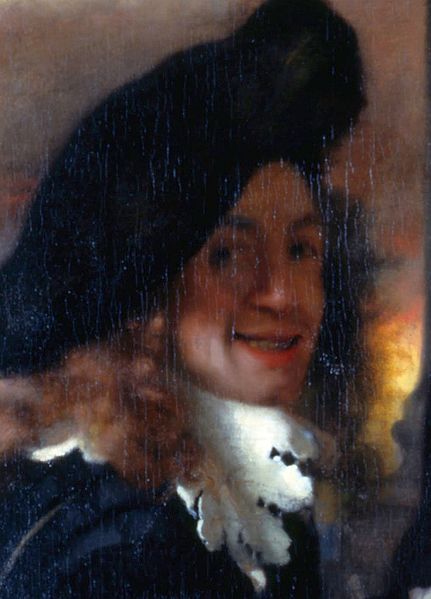
Born: Baptized 31 October 1632, Delft
Died: 15 December 1675 (aged 43)
Period: Dutch Golden Age, Baroque
The Life of Johannes Vermeer
Johannes Vermeer was a Dutch painter who is one of the most esteemed figures in the history of art, known for his exquisite handling of light and color and his meticulous attention to detail. Born in the city of Delft, in the Dutch Republic, Vermeer lived there for most of his life. Little is known about his early training, but it is believed that he was self-taught or apprenticed to a local master. He was admitted to the Delft painters’ guild in 1653 and remained in the city, working in relative obscurity, with his art primarily appreciated by a small circle of patrons.
Vermeer’s oeuvre is quite small, with only about 34 paintings attributed to him with certainty. His works are characterized by a calm, timeless sense of composition and an extraordinary ability to depict the effects of light and color. Vermeer often portrayed domestic interior scenes of middle-class life, showing people engaged in everyday activities such as reading letters, playing musical instruments, or engaged in quiet contemplation. His paintings are remarkable for their purity of light and form, precise composition, and meticulous attention to detail, aspects that contribute to the tranquil and introspective atmosphere that defines his work.
Among Vermeer’s most famous paintings are “Girl with a Pearl Earring” (c. 1665), which has captivated audiences with its enigmatic subject and masterful depiction of light, and “The Milkmaid” (c. 1658), praised for its vibrant depiction of simple domestic activity and the interplay of light and texture. Other notable works include “View of Delft” (c. 1660-1661), which displays his exceptional skill in landscape painting and atmospheric perspective, and “The Art of Painting” (c. 1666-1668), a complex work reflecting on the nature of art and illusion.
Vermeer’s work did not gain widespread recognition until the 19th century, centuries after his death. Since then, his reputation has grown, and he is now celebrated as a master of the Dutch Golden Age. Vermeer’s ability to capture the beauty in everyday moments and his unparalleled skill in the use of light and color have ensured his place as one of the most admired painters in the history of art. His works continue to fascinate and inspire both art lovers and artists alike for their serene beauty and profound depth.
Johannes Vermeer’s Notable Works
Johannes Vermeer, a master of the Dutch Golden Age, is celebrated for his exquisite treatment of light and detail in intimate domestic scenes. Though only about 34 of his paintings are widely recognized today, several stand out as iconic masterpieces in the history of art. Here are ten of Vermeer’s most famous and revered works:
- Girl with a Pearl Earring (c. 1665) – Often referred to as the “Mona Lisa of the North,” this captivating portrait is renowned for its enigmatic subject and the delicate interplay of light on her face and pearl earring.
- The Milkmaid (c. 1658) – A testament to Vermeer’s mastery of light and texture, this painting depicts a maid pouring milk, capturing a moment of simple domestic life with profound beauty and tranquility.
- The Art of Painting (c. 1666-1668) – This complex and meticulously detailed work shows an artist in his studio painting a model, believed to be an allegory of painting itself. It is celebrated for its rich symbolism and technical prowess.
- View of Delft (c. 1660-1661) – One of Vermeer’s few landscapes, this cityscape is admired for its realistic portrayal of Delft and its use of light and shadow, showcasing Vermeer’s extraordinary skill in capturing the atmosphere.
- The Girl with the Wine Glass (c. 1659-1660) – Featuring a group of figures in an interior, this work is noted for its intricate play of light and the psychological interplay between the characters.
- Woman Holding a Balance (c. 1664) – This painting depicts a woman weighing pearls or gold, symbolizing moral and spiritual contemplation. The balance between light and dark elements underscores the painting’s thematic depth.
- The Music Lesson (c. 1662-1665) – Showcasing a woman and her instructor at a virginal, this piece is lauded for its perspective, the reflective effects, and the serene mood, embodying the harmony of music and painting.
- Officer and Laughing Girl (c. 1657) – This work is celebrated for its composition, the contrast between the figures, and the detailed depiction of the map on the wall, highlighting Vermeer’s interest in perspective and spatial dynamics.
- The Astronomer (c. 1668) – Paired with “The Geographer,” this painting explores the theme of scientific inquiry, emphasizing the importance of observation and study, and is noted for its detailed depiction of the instruments and thoughtful composition.
- The Geographer (c. 1669) – A companion piece to “The Astronomer,” it portrays a man engrossed in study, surrounded by maps and a globe. The painting is admired for its representation of intellectual endeavor and the detailed treatment of the subject’s engagement with his work.
These works collectively illustrate Vermeer’s unparalleled ability to convey the beauty and profundity of everyday life, his innovative use of light and color, and his meticulous attention to detail, securing his legacy as one of the greatest painters of the Dutch Golden Age.